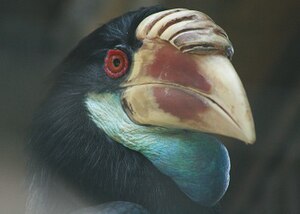Sumba hornbird
| Sumba hornbird | ||||||||||
|---|---|---|---|---|---|---|---|---|---|---|

Sumba hornbird |
||||||||||
| Systematics | ||||||||||
|
||||||||||
| Scientific name | ||||||||||
| Rhyticeros everetti | ||||||||||
| ( Rothschild , 1897) |
The Sumbavogel ( Rhyticeros everetti ) is a species of bird in the family of hornbills , exclusively on the Indonesian island of Sumba occurs.
The population of the sumbahorn bird was classified in the IUCN Red List of Threatened Species in 2016 as “ Vulnerable (VU) ”.
Appearance
The humba hornbill reaches a body length of 55 centimeters. The male's beak is 14.6 centimeters on average, while the female's beak is only slightly smaller at 14 centimeters. The sexual dimorphism is hardly pronounced in this species.
Characteristics of the male
The head and neck of the male are dark brown. The body plumage, wings and tail are black. The top of the body shimmers metallic green. The beak is pale yellow with a reddish brown spot in the center of the beak that extends over the lower and upper beak. The typical rhinoceros horn has up to six shallow grooves. It is pale yellow to horn-colored. The bare skin around the eye is dark blue. The eyelids are bright pink and form a ring around the eye. The bare throat patch is very large in the humba hornbill. It is pale blue in color with a dark blue spot just below the throat. The eyes are red-brown, the legs and feet are black.
Features of the female and young birds
The adult females are smaller than the males and have black head and neck plumage. The female resembles the male in all other characteristics.
In the young birds, both sexes initially show a body plumage that resembles the male. Adolescent females later molt into the dark neck and head plumage, as is typical for adult females. The beak is pale yellow and the beak horn is not yet developed.
Distribution area and habitat
The humba hornbill occurs exclusively on the island of Sumba, an 11,150 km² island of the Lesser Sunda Islands , which belongs to the Indonesian province of East Nusa Tenggara . The island is traversed in a west-east direction by an approximately 150 km long and up to 40 km wide region with mountains, which divides the climate into two areas. In the south-west half of the year, with up to 1,600 mm, more rain falls than in the drier north-east, where precipitation is sometimes less than 600 mm per year.
The humba hornbill needs primary forest as habitat. It only looks for secondary forest and sparse tree-lined areas while searching for food. Today the island only has such suitable primary forest on 16 percent of the area. Only hills and steep valleys at high altitudes are forested. Large fig trees were once typical inland, but have largely been displaced by the subsistence economy of the island's now more than 600,000 inhabitants.
Way of life
The humba hornbill occurs predominantly in pairs or in small family groups. Occasionally up to 70 birds gather in common resting places. Pairs separate from such troops one to two months before the start of the breeding season. Subadult birds stay together in small flocks.
So far, only fruit has been found to be a food in humbug maples. Abundant trees are vigorously defended against food competitors. As with almost all other hornbills, it is possible that a small proportion of animal food is part of the food spectrum.
The reproductive behavior of the sumbahorn bird has not yet been conclusively investigated.
Sumba hornbird and human
The Sumba hornbill was traditionally hunted and eaten on Sumba. This hunt still takes place today. Compared to the widespread destruction of the habitat of this bird species, however, it is not an essential factor in the decline in the population.
Trivia
The specific epithet honors Alfred Hart Everett (1848–1898), a British civil servant and administrative clerk in Borneo who made a name for himself as an ornithologist , naturalist and zoological collector.
literature
- W. Grummt , H. Strehlow (Ed.): Zoo animal keeping birds. Verlag Harri Deutsch, Frankfurt am Main 2009, ISBN 978-3-8171-1636-2 .
- Alan Kemp: The Hornbills - Bucerotiformes. Oxford University Press, Oxford 1995, ISBN 0-19-857729-X .
Web links
- Rhyticeros everetti in the endangered Red List species the IUCN 2012. Posted by: BirdLife International, 2012. Accessed November 1, 2016th
- Calls of the sumbahorn bird on Xeno-Canto
Single receipts
- ↑ Rhyticeros everetti in the endangered Red List species the IUCN 2016 Posted by: BirdLife International, 2016. Retrieved on 3 October 2017th
- ↑ a b c Kemp: The Hornbills - Bucerotiformes. P. 239.
- ↑ a b Kemp: The Hornbills - Bucerotiformes. P. 240.
- ↑ Bo Beolens, Michael Watkins: Whose Bird? Men and Women Commemorated in the Common Names of Birds . Christopher Helm, London 2003, ISBN 0-7136-6647-1 , pp. 205 .
